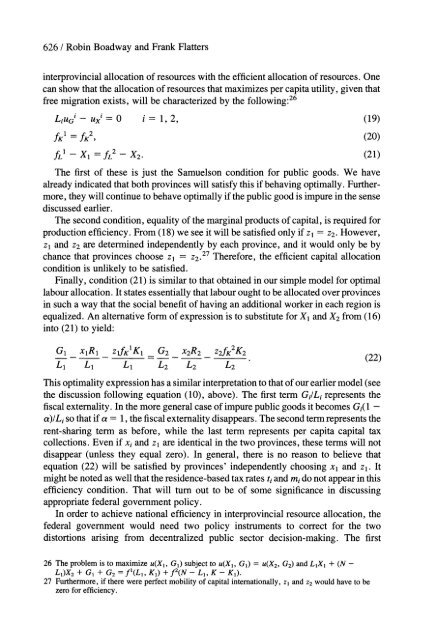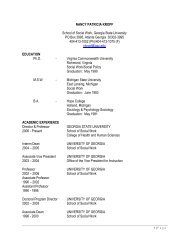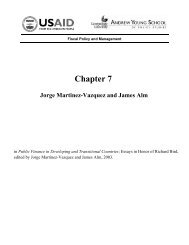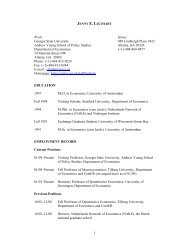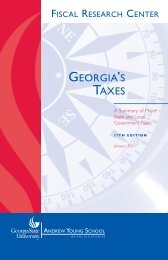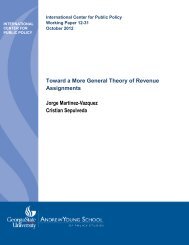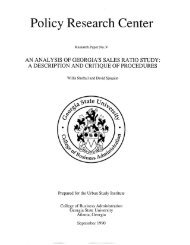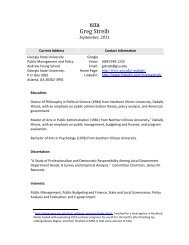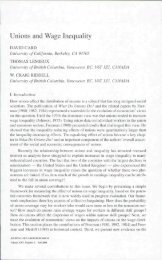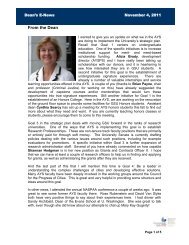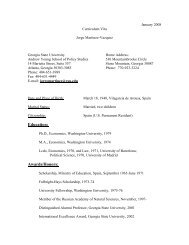Robin Boadway and Frank Flatters - Andrew Young School of Policy ...
Robin Boadway and Frank Flatters - Andrew Young School of Policy ...
Robin Boadway and Frank Flatters - Andrew Young School of Policy ...
Create successful ePaper yourself
Turn your PDF publications into a flip-book with our unique Google optimized e-Paper software.
626 / <strong>Robin</strong> <strong>Boadway</strong> <strong>and</strong> <strong>Frank</strong> <strong>Flatters</strong><br />
interprovincial allocation <strong>of</strong> resources with the efficient allocation <strong>of</strong> resources. One<br />
can show that the allocation <strong>of</strong> resources that maximizes per capita utility, given that<br />
free migration exists, will be characterized by the following:26<br />
LiuGi -uxi = 0 i = 1, 2, (19)<br />
fK1 = fK2, (20)<br />
fL1 - X1 = fL - X2. (21)<br />
The first <strong>of</strong> these is just the Samuelson condition for public goods. We have<br />
already indicated that both provinces will satisfy this if behaving optimally. Furthermore,<br />
they will continue to behave optimally if the public good is impure in the sense<br />
discussed earlier.<br />
The second condition, equality <strong>of</strong> the marginal products <strong>of</strong> capital, is required for<br />
production efficiency. From (18) we see it will be satisfied only if zl = Z2. However,<br />
zl <strong>and</strong> Z2 are determined independently by each province, <strong>and</strong> it would only be by<br />
chance that provinces choose zl = 22.27 Therefore, the efficient capital allocation<br />
condition is unlikely to be satisfied.<br />
Finally, condition (21) is similar to that obtained in our simple model for optimal<br />
labour allocation. It states essentially that labour ought to be allocated over provinces<br />
in such a way that the social benefit <strong>of</strong> having an additional worker in each region is<br />
equalized. An alternative form <strong>of</strong> expression is to substitute for X1 <strong>and</strong> X2 from (16)<br />
into (21) to yield:<br />
G1 XlR1 ZlK1K1l G2 x2R2 Z2fK2K2<br />
L1 L1 L1 L2 L2 L2<br />
This optimality expression has a similar interpretation to that <strong>of</strong> our earlier model (see<br />
the discussion following equation (10), above). The first term Gi/Li represents the<br />
fiscal externality. In the more general case <strong>of</strong> impure public goods it becomes Gi(1 -<br />
a)lLi so that if a = 1, the fiscal externality disappears. The second term represents the<br />
rent-sharing term as before, while the last term represents per capita capital tax<br />
collections. Even if xi <strong>and</strong> zl are identical in the two provinces, these terms will not<br />
disappear (unless they equal zero). In general, there is no reason to believe that<br />
equation (22) will be satisfied by provinces' independently choosing xl <strong>and</strong> zi. It<br />
might be noted as well that the residence-based tax rates ti <strong>and</strong> mi do not appear in this<br />
efficiency condition. That will turn out to be <strong>of</strong> some significance in discussing<br />
appropriate federal government policy.<br />
In order to achieve national efficiency in interprovincial resource allocation, the<br />
federal government would need two policy instruments to correct for the two<br />
distortions arising from decentralized public sector decision-making. The first<br />
26 The problem is to maximize u(Xi, G1) subject to u(X1, G1) = u(X2, G2) <strong>and</strong> L1Xi + (N -<br />
L1)X2 + G1 + G2 = f'(L, K,) + f(N - L1, K - K1).<br />
27 Furthermore, if there were perfect mobility <strong>of</strong> capital internationally, zl <strong>and</strong> z2 would have to be<br />
zero for efficiency.<br />
(22)


